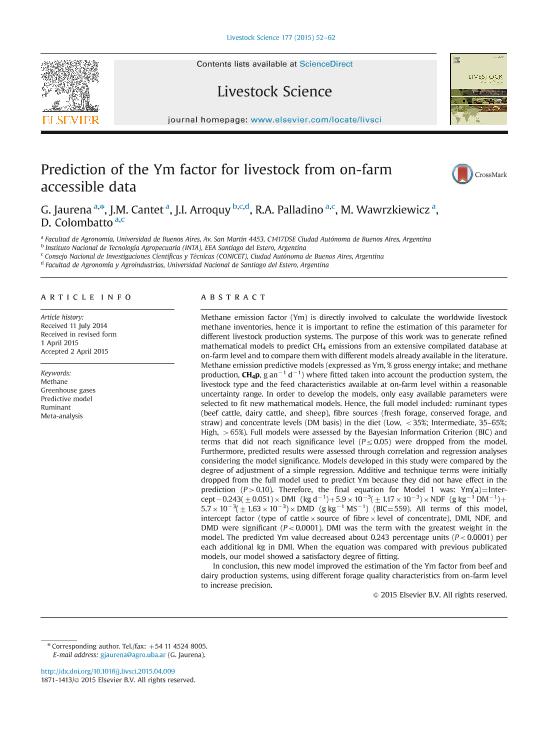Mostrar el registro sencillo del ítem
dc.contributor.author
Jaurena, Gustavo

dc.contributor.author
Cantet, Juan Manuel

dc.contributor.author
Arroquy, Jose Ignacio

dc.contributor.author
Palladino, Rafael Alejandro

dc.contributor.author
Wawrzkiewicz, Marisa

dc.contributor.author
Colombatto, Dario

dc.date.available
2018-04-11T17:24:11Z
dc.date.issued
2015-07
dc.identifier.citation
Jaurena, Gustavo; Cantet, Juan Manuel; Arroquy, Jose Ignacio; Palladino, Rafael Alejandro; Wawrzkiewicz, Marisa; et al.; Prediction of the Ym factor for livestock from on-farm accessible data; Elsevier Science; Livestock Science; 177; 52; 7-2015; 52-62
dc.identifier.issn
1871-1413
dc.identifier.uri
http://hdl.handle.net/11336/41723
dc.description.abstract
Methane emission factor (Ym) is directly involved to calculate the worldwide livestock methane inventories, hence it is important to refine the estimation of this parameter for different livestock production systems. The purpose of this work was to generate refined mathematical models to predict CH4 emissions from an extensive compilated database at on-farm level and to compare them with different models already available in the literature. Methane emission predictive models (expressed as Ym, % gross energy intake; and methane production, CH4p, g an−1 d−1) where fitted taken into account the production system, the livestock type and the feed characteristics available at on-farm level within a reasonable uncertainty range. In order to develop the models, only easy available parameters were selected to fit new mathematical models. Hence, the full model included: ruminant types (beef cattle, dairy cattle, and sheep), fibre sources (fresh forage, conserved forage, and straw) and concentrate levels (DM basis) in the diet (Low, <35%; Intermediate, 35–65%; High, >65%). Full models were assessed by the Bayesian Information Criterion (BIC) and terms that did not reach significance level (P≤0.05) were dropped from the model. Furthermore, predicted results were assessed through correlation and regression analyses considering the model significance. Models developed in this study were compared by the degree of adjustment of a simple regression. Additive and technique terms were initially dropped from the full model used to predict Ym because they did not have effect in the prediction (P>0.10). Therefore, the final equation for Model 1 was: Ym(a)=Intercept−0.243(±0.051)×DMI (kg d−1)+5.9×10−3(±1.17×10−3)×NDF (g kg−1 DM−1)+5.7×10−3(±1.63×10−3)×DMD (g kg−1 MS−1) (BIC=559). All terms of this model, intercept factor (type of cattle×source of fibre×level of concentrate), DMI, NDF, and DMD were significant (P<0.0001). DMI was the term with the greatest weight in the model. The predicted Ym value decreased about 0.243 percentage units (P<0.0001) per each additional kg in DMI. When the equation was compared with previous publicated models, our model showed a satisfactory degree of fitting.
dc.format
application/pdf
dc.language.iso
eng
dc.publisher
Elsevier Science

dc.rights
info:eu-repo/semantics/openAccess
dc.rights.uri
https://creativecommons.org/licenses/by-nc-nd/2.5/ar/
dc.subject
Methane
dc.subject
Green House Gases
dc.subject
Predictive Model
dc.subject.classification
Otras Producción Animal y Lechería

dc.subject.classification
Producción Animal y Lechería

dc.subject.classification
CIENCIAS AGRÍCOLAS

dc.title
Prediction of the Ym factor for livestock from on-farm accessible data
dc.type
info:eu-repo/semantics/article
dc.type
info:ar-repo/semantics/artículo
dc.type
info:eu-repo/semantics/publishedVersion
dc.date.updated
2018-04-11T16:00:27Z
dc.journal.volume
177
dc.journal.number
52
dc.journal.pagination
52-62
dc.journal.pais
Países Bajos

dc.journal.ciudad
Amsterdam
dc.description.fil
Fil: Jaurena, Gustavo. Universidad de Buenos Aires. Facultad de Agronomía; Argentina
dc.description.fil
Fil: Cantet, Juan Manuel. Universidad de Buenos Aires. Facultad de Agronomía; Argentina. Consejo Nacional de Investigaciones Científicas y Técnicas; Argentina
dc.description.fil
Fil: Arroquy, Jose Ignacio. Instituto Nacional de Tecnología Agropecuaria. Centro Regional Tucumán-Santiago del Estero. Estación Experimental Agropecuaria Santiago del Estero; Argentina. Universidad Nacional de Santiago del Estero. Facultad de Agronomía y Agroindustrias; Argentina. Consejo Nacional de Investigaciones Científicas y Técnicas; Argentina
dc.description.fil
Fil: Palladino, Rafael Alejandro. Universidad de Buenos Aires. Facultad de Agronomía; Argentina. Consejo Nacional de Investigaciones Científicas y Técnicas; Argentina
dc.description.fil
Fil: Wawrzkiewicz, Marisa. Universidad de Buenos Aires. Facultad de Agronomía; Argentina
dc.description.fil
Fil: Colombatto, Dario. Universidad de Buenos Aires. Facultad de Agronomía; Argentina. Consejo Nacional de Investigaciones Científicas y Técnicas; Argentina
dc.journal.title
Livestock Science

dc.relation.alternativeid
info:eu-repo/semantics/altIdentifier/doi/http://dx.doi.org/10.1016/j.livsci.2015.04.009
dc.relation.alternativeid
info:eu-repo/semantics/altIdentifier/url/http://www.livestockscience.com/article/S1871-1413(15)00190-0/fulltext
dc.relation.alternativeid
info:eu-repo/semantics/altIdentifier/url/https://www.sciencedirect.com/science/article/pii/S1871141315001900
Archivos asociados
